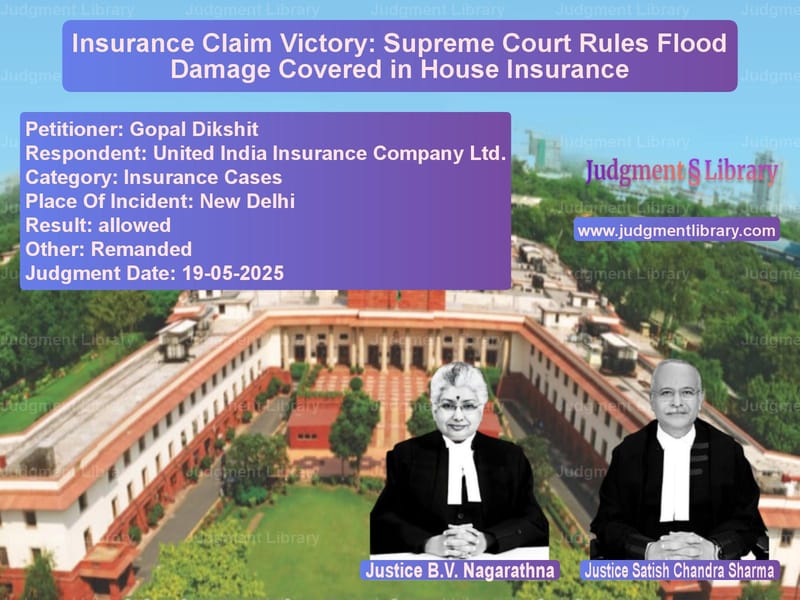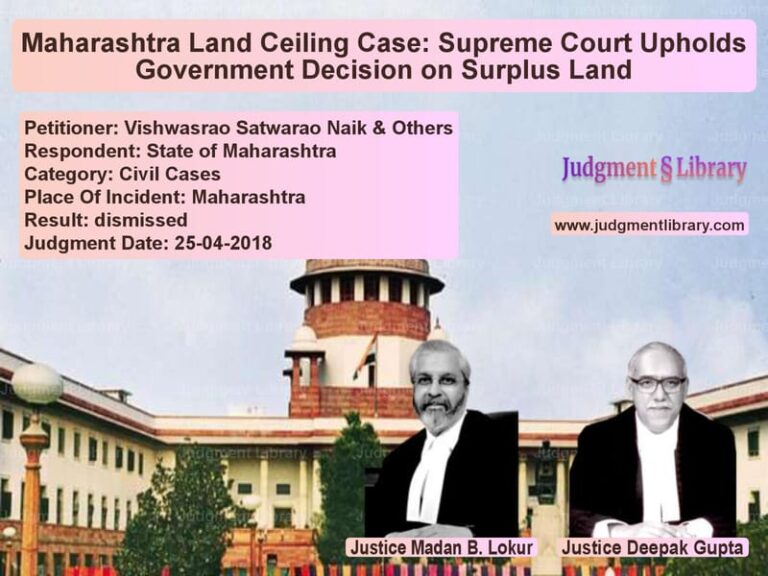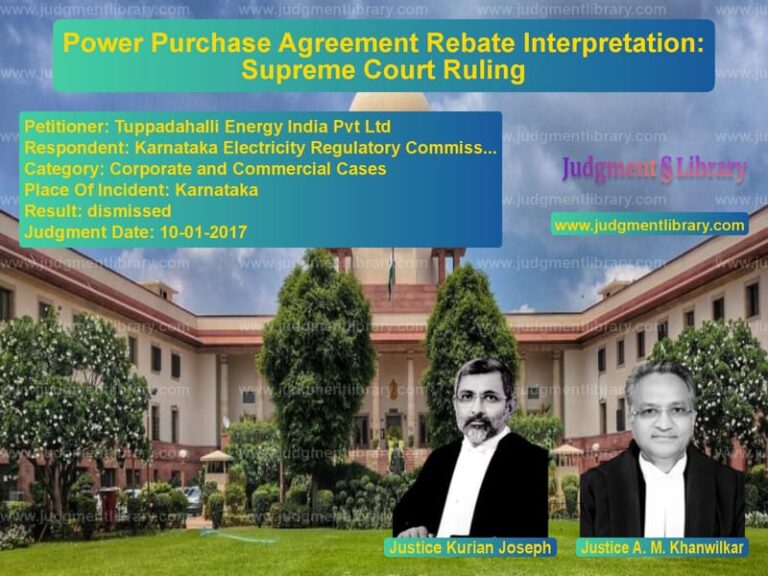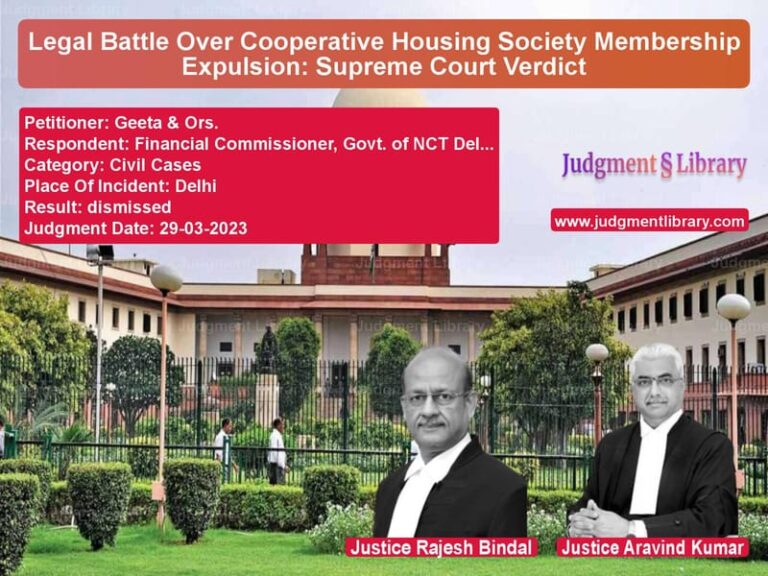Insurance Claim Victory: Supreme Court Rules Flood Damage Covered in House Insurance
In a significant victory for insurance consumers, the Supreme Court of India recently delivered a landmark judgment that clarifies the distinction between flood damage and seepage in house insurance claims. The case of Gopal Dikshit versus United India Insurance Company Ltd. represents a classic example of how insurance companies sometimes attempt to deny legitimate claims by using technical interpretations of policy terms. This judgment not only provides relief to an individual policyholder but also establishes important principles that will benefit countless homeowners across India who face similar challenges when dealing with insurance companies after natural calamities or unexpected damage to their properties.
The legal battle began with a residential property located at 50, Ishwar Nagar, Mathura Road, New Delhi, owned by Gopal Dikshit. The premises, which included a basement, ground floor, first floor, and second floor, was insured with United India Insurance Company under a House Holder Insurance Policy for Rs. 1.50 crores, valid from March 13, 2016, to March 12, 2017. The policy covered various risks, including flood and inundation, which would become the central point of contention in the subsequent legal proceedings.
The unfortunate incident occurred during the period from August 25 to August 31, 2016, when Delhi experienced heavy rainfall. During this time, the appellant was out of Delhi from August 24 to August 29, 2016. Upon his return, he discovered that the basement of his premises was severely flooded with water, causing extensive damage to furniture, fittings, almirahs, books, and other belongings stored there. In an effort to mitigate further damage, the appellant installed a booster pump on August 30, 2016, to drain the water from the basement, but the accumulated floodwater could not be completely removed.
The insurance claim process began with the appointment of a surveyor, Mr. Akash Chopra, who visited the premises on September 3, 2016, and inspected the basement. However, the insurance company expressed dissatisfaction with his preliminary findings and appointed a second surveyor, Mr. R.K. Singla, who conducted another survey. Meanwhile, the appellant sought the opinion of two structural engineers regarding the safety of the premises. Both engineers concluded that the building was no longer fit for habitation, had become structurally unsafe, and recommended that it be vacated immediately and demolished for reconstruction.
The turning point in the claim process came when the appellant was informed by Ms. Indu Singh of the insurance company that due to the use of the term “seepage” in the survey reports, the insurance claim would not be admissible. Subsequently, on November 23, 2016, the appellant received a formal letter from the insurance company repudiating his claim. The rejection was based on the ground that the damage to the building was caused by continuous seepage of water from the basement, which was not listed as a named peril under the insurance policy, and therefore the resulting loss or damage was not indemnifiable.
Aggrieved by this decision, the appellant filed Consumer Case No. 2287 of 2017 before the National Consumer Disputes Redressal Commission (NCDRC). However, the NCDRC dismissed the complaint, leading to the present appeal before the Supreme Court.
Before the Supreme Court, the learned counsel for the appellant presented compelling arguments challenging the insurance company’s decision. The counsel submitted that “judgments of NCDRC have consistently held that ‘flood’ means outpouring of water and on this analogy, it would include both inundation and seepage.” This argument sought to establish that even if the damage was caused by seepage, it should be covered under the flood insurance provision.
The appellant’s counsel further emphasized the meteorological evidence, stating that “NCDRC ought to have relied on the Meteorological Department Report stating that Delhi had rainfall during the period of 25.08.2016 to 31.08.2016.” He explained that “it is a common practice in Delhi that on a particular day certain portions of Delhi received scanty rainfall whereas other pockets received heavy rainfall. In the case of the Appellant, the Ishwar Nagar area received heavy rainfall and as such there was flooding in the area.”
Addressing the crucial distinction between flooding and seepage, the counsel argued that “‘seepage’ refers to the slow and gradual flow of liquid from a source. In the present case, the basement had accumulated over 3 feet of water within a span of just three days while the Appellant was away from Delhi. The Appellant respectfully contended that such rapid and substantial flooding cannot be classified as ‘seepage’ as seepage does not result in the sudden inundation of a basement with three feet of water.”
The counsel also highlighted the procedural irregularities in the insurance company’s handling of the claim, noting that “the first surveyor visited the site on 03.09.2016 while the 2nd Surveyor visited the site only on 09.09.2016 i.e. 10 days after the reporting of the incident to the Respondent. It was respectfully submitted that no prudent person would allow the water to stay in the premises for 10 days and further facilitate in destroying his belongings kept in the basement.”
Regarding the survey reports, the counsel pointed out that “in its Report dated 06.09.2016, the Surveyor specifically states that the cause of loss was: ‘Due to heavy rains in Delhi on 25.08.2016 the water entered from the flooring, resulted in damages to the insured’s building and contents.’ It is submitted that the Survey Report dated 06.09.2016 was never taken into consideration by the Respondent and instead the Respondent opted to go for another survey which was conducted 10 days after the incident occurred.”
On the other side, the learned counsel for the respondent insurance company vehemently defended the rejection of the claim. The counsel argued that “even if ‘seepage’ encompasses both inundation and seepage, it is pertinent to note that each case is distinct and should be evaluated/assessed based on its individual set of circumstances and the specific terms laid out in the contract.” He emphasized that “the specific terms and conditions of the policy do not encompass seepage as a covered peril. Consequently, the rejection of the Appellant’s claim aligns with the policy’s provisions.”
The insurance company’s counsel challenged the appellant’s timeline of events, contending that “the Appellant’s claim timeline, ranging from 25th to 31st August 2016, raises substantial questions regarding its reliability and consistency, leaving room for doubt as to whether it was introduced as an afterthought to buttress its claim by the Appellant.” He further stated that “upon thorough examination of the Meteorological Report dated 25th to 31st August, 2016, submitted by the Appellant, it was observed by NCDRC that there is no mention of heavy rainfall on 25.08.2016.”
The respondent’s counsel elaborated on the nature of seepage, arguing that “the interpretation of ‘seepage’ as a gradual process aligns with the prevailing circumstances in this case. The understanding of seepage, especially in the context of a basement or foundation, acknowledges its potential for a prolonged occurrence, as water gradually infiltrates and accumulates. It is submitted that seepage is not confined to insignificant or minimal quantities of water, but rather refers to the unauthorized infiltration of water into areas where it should not be, resulting in the progressive accumulation of water over time.”
The Supreme Court bench comprising Justice B.V. Nagarathna and Justice Satish Chandra Sharma carefully examined the submissions and evidence on record. The court conducted a thorough analysis of the various certificates and survey reports, which proved decisive in reaching its conclusion.
The court first examined the First Survey Report dated September 6, 2016, noting that “on perusal of the first survey report dated 06.09.2016 conducted by Mr. Akash Chopra on 03.09.2016, it can be observed that cause of loss noted in the report is heavy rains in Delhi on 25.08.2016, during which period, the water entered from the flooring and that resulted in damage to the Appellant’s premises. It was further noted that based on the inspection, the report confirmed that water was found coming from the flooring and had not come from the main entrance and/or any openings. The aforesaid survey report was clear about the cause of loss to the said Premises.”
The court then analyzed the certificate issued by M/s International Consultants & Technocrats Pvt. Ltd., observing that “on assessment of the amended certificate issued by them, which stated that the damage was due to the flooding of water into the basement which happened due to heavy rainfall, it can be comprehended that the damage to the premises was not due to seepage but was caused by flooding of water.”
Regarding the certificate issued by Unique Consulting Engineers, the court found that “upon a thorough review of the statement issued by them, it becomes evident that no causal link can be established between the subject matter of the certificate and the cause of damage that has occurred. The certificate in question specifically addresses water seepage affecting the structural elements of the building, noting a consequent reduction in the overall structural integrity. However, it makes no reference whatsoever to the basement area or any damage that may have occurred therein. Thus, the aforesaid certificate fails to substantiate any connection between the structural issues and the cause of damage in question in the premises.”
The court also considered the certificate issued by M/s Chordia Engineering Consultancy Services, which “clearly notes that during the site visit conducted by the concerned representative, the basement of the insured premises was found to be flooded. This flooding was attributed to a heavy downpour that had occurred in the last week of August. As per the observations recorded, the ingress of water into the basement was a direct result of this excessive rainfall. Thus, the certificate establishes that the cause of damage was not due to any structural failure or seepage water but rather a consequence of the intense rainfall experienced during that period.”
Based on this comprehensive analysis, the Supreme Court concluded that “upon a careful examination of the material on record, including the first survey report and certificates submitted by various technical experts, it is evident that the cause of damage to the insured premises was the flooding of water into the basement due to heavy rainfall in Delhi during the relevant period.”
The court was particularly critical of the insurance company’s decision to commission a second survey, noting that “our attention is drawn to the final survey and assessment report dated 18.10.2016, which was prepared following a second survey conducted on the insured premises approximately ten days after the occurrence of the said incident. It is pertinent to note that the first survey, conducted promptly on 03.09.2016, had already comprehensively assessed the cause and extent of the damage, and there is nothing on record to suggest that it was deficient or incomplete in any manner. Despite conducting a survey before, the Respondent proceeded to commission a second survey without furnishing any reasonable, cogent, or valid grounds justifying the necessity for a reassessment.”
The court found that “the second survey report dated 18.10.2016 deviated from the reasons of the first survey report and curiously recorded that the damage to the premises was caused by seepage, rather than by flooding due to heavy downpour. However, the second survey report failed to counter or address the detailed and comprehensive observations made in the first survey report dated 06.09.2016, nor did it offer any explanation or new material facts that would warrant a reversal of the initial conclusion. This abrupt departure from the earlier findings, without explanation or justification, raises serious concerns about the reliability and objectivity of the second survey.”
In its final ruling, the Supreme Court set aside the NCDRC’s order and the insurance company’s rejection of the claim. The court remanded the matter back to the NCDRC “for the limited purpose of determining the appropriate quantum of compensation payable to the Appellant in accordance with the policy terms and applicable law.”
This judgment represents a significant victory for insurance consumers and establishes important principles regarding the interpretation of insurance policies, particularly in cases involving natural calamities. The Supreme Court’s emphasis on the primacy of the first survey report and its skepticism toward belated reassessments that contradict initial findings without justification will serve as an important precedent for future insurance disputes. The judgment also reinforces the consumer-friendly approach that courts should adopt when interpreting insurance contracts, ensuring that technical interpretations do not defeat the legitimate claims of policyholders.
Petitioner Name: Gopal Dikshit.Respondent Name: United India Insurance Company Ltd..Judgment By: Justice B.V. Nagarathna, Justice Satish Chandra Sharma.Place Of Incident: New Delhi.Judgment Date: 19-05-2025.Result: allowed.
Don’t miss out on the full details! Download the complete judgment in PDF format below and gain valuable insights instantly!
Download Judgment: gopal-dikshit-vs-united-india-insuran-supreme-court-of-india-judgment-dated-19-05-2025.pdf
Directly Download Judgment: Directly download this Judgment
See all petitions in Fire and Property Insurance Cases
See all petitions in Insurance Settlements
See all petitions in Commercial Insurance Disputes
See all petitions in Other Insurance Cases
See all petitions in Judgment by B.V. Nagarathna
See all petitions in Judgment by Satish Chandra Sharma
See all petitions in allowed
See all petitions in Remanded
See all petitions in supreme court of India judgments May 2025
See all petitions in 2025 judgments
See all posts in Insurance Cases Category
See all allowed petitions in Insurance Cases Category
See all Dismissed petitions in Insurance Cases Category
See all partially allowed petitions in Insurance Cases Category







